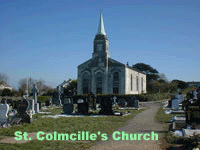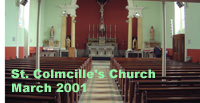St Colmcille's Church
Marble PlaqueThere is a marble plaque at the back of the Church which lists the parish priests of Swords from 1608 onwards (Kiernan is spelled as Ciernan). Father John MurphyDuring the Cromwellian era, the priests were forced to hide otherwise they would be imprisoned, but by 1660, this persecution had ceased, and Fr John Murphy, Parish Priest, was allowed back into Swords. In 1665, Fr Murphy presented a sliver chalice to Swords, and this implies that the first public chapel was established around this time. Reverend James CareyJames CareyIn 1806, Rev. James Carey, OP was appointed as parish priest, and he ministered in Swords until his death in 1850. He was a member of the Dominican Order, and special permission was given for him to work in Swords. In 1827, he replaced the old chapel by building St Colmcille’s Church on a site presented by Mr James Taylor of Swords House. In 1879, the two-storey vestry at the rear of the church was added on. The main altar, side altars and communion rails were erected to the memory of Fr David Mulcahy PP who died in 1912.
|
St. Colmcille’s Boys’ National School, Chapel Lane, Swords, Co.Dublin K67 WP65
(01) 8405132

 If we turn come back up Seatown Road and turn left, we will arrive at St Colmcille’s Church and the Graveyard. The archives of the Vatican mention a church and residence in Swords as early as 1608, with Niel Kiernan, a priest of the Diocese of Armagh, being referred to as priest for the area.
If we turn come back up Seatown Road and turn left, we will arrive at St Colmcille’s Church and the Graveyard. The archives of the Vatican mention a church and residence in Swords as early as 1608, with Niel Kiernan, a priest of the Diocese of Armagh, being referred to as priest for the area.





